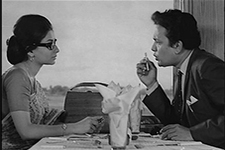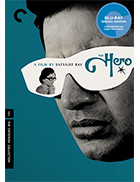The Hero (Nayak)
|  Satyajit Ray’s fourteenth feature film, The Hero (Nayak), marked a new phase in the Indian auteur’s long and varied career, as he began branching off into new and previously unexplored territory. Having first gained international acclaim for his “Apu Trilogy” (Pather Panchali, 1955; Aparajito , 1956; and Apu Sansar, 1959), which followed the growth from childhood to young adulthood of a boy from a poor village in West Bengal, he spent much of the 1960s making a series of films that challenged traditional Indian notions of femininity. The Big City (1963), for example, depicted a lower middle-class woman bucking tradition by going to work to help support her family, while Charulata (1964) was a chamber drama about a miserable bourgeois wife who longs to escape the confines of her gilded existence. The Hero marked a break away from many of the conventions that had become typical of Ray’s cinema at that point, although it maintained his fundamental humanism as embodied in his willingness to see the world through the eyes of multiple characters, even if those worldviews were sometimes in collision. There are rarely villains in Ray’s films, as he is more interested in characters whose imperfections he can observe and explore as a means of getting closer to what it means to be human. Ray’s films are often described as “simple,” yet it is, in the words of the film critic Pauline Kael, “simplicity arrived at, achieved, a master’s distillation from his experience … simplicity to which we must respond with feeling.” The Hero is clearly a distillation of Ray’s own experience, as it is set within the world of Indian cinema. More specifically, it is set within the world of the dominant Mumbai-centered film industry that Ray was consciously rebelling against when he directed the West Bengal-set Pather Panchali, which became the first independently produced Indian film to achieve international attention. (It was only the second film he made from an original script, the first being 1962’s Kanchenjungha, a unique real-time depiction of an upper-class Bengali family on vacation). The Hero is primarily a commentary on the nature of mainstream cinema and the potentially life-throttling celebrity it engenders. The film takes place over a 24-hour period and is confined largely to the interior of a train travelling from Kolkata and Delhi. Trains have long played an important role in Ray’s cinema, usually as symbols of modernization and escape from rural poverty, so this film’s being set almost entirely aboard one is fraught with even more meaning that one might initially assume. The main character is Arindam Mukherjee, a matinee idol played by Uttam Kumar, who was at the time and still is one of the most famous and beloved of Indian actors. This was the first time that Ray had worked with a major star, and he cast Mukherjee because he could immediately convey the essence of already established celebrity, but also because he was a great actor capable of a wide range of nuanced emotional registers. Part of what makes The Hero engaging is the manner in which Arindam slowly lets his guard down and allows the human behind the celebrity façade (literalized by his extra dark sunglasses) to emerge. The catalysts for this emergence is his meeting Aditi Sengupta (Sharmila Tagore), a young woman who edits a progressive women’s magazine. Aditi has little to no interest in Arindam’s celebrity outside of a general sense of derision for its falsity and arrogance, but she approaches him for an autograph at the behest of the smitten couple next to whom she is sitting on the train. She and Arindam get to talking, and he offers her an interview for her magazine even though it is not the type of publication that goes in for gossip and celebrity puff-pieces (she does recognize, however, that such an interview would boost the readership of her struggling publication; idealism, unfortunately, does not pay the rent). Aditi agrees, and what follows over the rest of the afternoon and evening is an unfolding of Arindam’s life experience, from the time he was a poor, struggling theatre actor, to his big break into the movies, and his ascent to the highest echelons of stardom. That stardom is already blemished, as we learn at the beginning of the film that he was recently involved in an altercation at a nightclub—exactly the kind of salacious tabloid fodder his agent wants to avoid. At the same time, he is travelling to accept a national award for his work, but he fears that his latest film, which is about to be released, will be a flop. And, as he is reminded more than once, it only takes a couple of flops to end an otherwise successful screen career. Thus, Arindam is struggling internally with feelings of insecurity and loneliness and self-doubt even though he appears to the untrained eye to “have it all.” As he says to Aditi early on, “It’s no good to talk too much. You see, we live in a world of shadows—so it’s best not to let the public see too much of our flesh and blood.” Yet, as he talks to Aditi, who is both a sympathetic ear and a gentle voice of reason and conscience, he finds himself divulging his “flesh and blood,” opening up parts of his life that he would otherwise keep concealed, including a story from his early years of stardom when he turned his back on an idealistic, politically engaged friend because it might threaten his popularity. We also see into his mind at times, including a dream in which he finds himself in a landscape of cash, eventually sinking into a money hole that couldn’t be any more obvious in its symbolizing the ultimately destructive nature of celebrity and its attendant riches. From that perspective, The Hero is not one of Ray’s strongest films, as much of its critique of the film industry and the celebrity it produces feels a bit too on the nose. Although specifically aimed at the Bollywood industry he spent his life avoiding, the basic truths conveyed are applicable to any kind of international celebrity machine, Hollywood definitely included. Thus, The Hero transcends its cultural milieu and temporal location in the mid-1960s and speaks very clearly to the here and now. (Its narrative about a film artist at a crossroads, reassessing his life partially through dreams certainly echoes Fellini’s 8 ½ [1963], although Ray, despite engaging in some formal experimentation, does not follow Fellini nearly so far down the fantasy rabbit hole.) Both Uttam Kumar, who had already appeared in well over 100 films at that point, and Sharmila Tagore, who Ray had discovered and first cast in Apu Sanar (1959) and then in The Goddess (1960), are fantastic in the central roles, and they develop a powerful chemistry that somehow manages to avoid suggestion of romantic attraction (one could imagine a much worse film taking that road). Instead, Ray presents them as fundamental opposites who nevertheless find a common ground on which to temporarily connect, which speaks more than anything to the great filmmaker’s view of humanity as millions of different sides to the same coin.
Copyright © 2018 James Kendrick Thoughts? E-mail James Kendrick All images copyright © The Criterion Collection | |||||||||||||||||||||||||||||||
Overall Rating: 

 (3)
(3)


